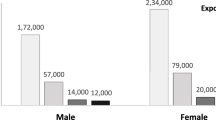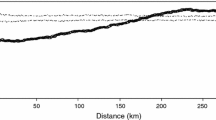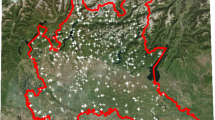Abstract
This paper examines the problem of estimating indoor radon concentrations for radon-induced lung cancer risk assessment. Previous authors have identified various problems and possible corrections for the use of generally available radon screening measurements. Bias evident in data collected from volunteers is described; regional databases developed from voluntary data generally exhibit higher mean values than those obtained from random samples. Tools are developed to better characterize the differences in voluntary and random concentration distributions. Application is demonstrated using voluntary and random radon survey data for the state of North Dakota.
Similar content being viewed by others
References
Alter, H. W., and Oswald, R. A.: 1987, ‘Nationwide Distribution of Indoor Radon Measurements: A Preliminary Data Base’, JAPCA, 37(3), 227–231.
Becker, R. A., Chambers, J. M., and Wilks, A. R.: 1988, The New S Language, Wadsworth & Brooks/Cole Advanced Software and Books, Pacific Grove, CA.
National Research Council Committee on Biological Effects of Ionizing Radiation (BEIR-IV): 1988, Health Risk of Radon and Other Internally Deposited Alpha-Emitters. National Academy Press, Wahington, D.C.
Bierma, T. J., Croke, K. G., and Swartzman, D.: 1989, ‘Accuracy and Prcision of Home Radon Monitoring and the Effectiveness of EPA Monitoring Guidelines’, JAPCA 39(7), 953–959.
Cohen, B. L., and Pondy, P.: 1987, ‘Comparison of Purchased Measurements in Randomly Selected Houses as a Source of Information on 222Rn Levels in Houses’, Health Physics 53(4), 409–415.
Cohen, B. L., and Gromicko, N.: 1988, ‘Variation of Radon Levels in U.S. Homes with Various Factors’, JAPCA 38(2), 129–134.
Cohen, B. L., and Shah: 1989, ‘Radon Levels by States and Counties’, data from the University of Pittsburgh Radon Project February 1986-May 1989.
Crawford, W. A.: 1988, ‘On Air Pollution, Environmental Tobacco Smoke, Radon, and Lung Cancer’, JAPCA 38(11), 1386–1391.
Desvouges, W. H., Smith, V. K., and Rink, H. H.: 1988, ‘Communicating Radon Risk Effectively: Radon Testing in Maryland, Final Report’, Research Triangle Institute, EPA Cooperative Agreement No. CR-811075 RT1 Project No. 3990-02, Research Triangle Park, NC.
Evans, J. S., Hawkins, N. C., and Graham, J. D.: 1988, ‘The Value of Monitoring for Radon in the Home: A Decision Analysis’, JAPCA 38(11), 1380–1385.
George, A. C.: 1986, ‘Instruments for Measuring Indoor Radon and Radon Progeny Concentrations’, Environmental Measurements Laboratory, U.S. Department of Energy, New York, in Indoor Radon: Proceedings: an APCA International Specialty Conference Sponsored by APCA's TT-7 Indoor Air Quality Committee, Pittsburgh, PA.
Harley, N. J.: 1989, ‘Methodology lssues in Exposure Assessment for Radon’, Seventh Symposium on Environmental Epidemiology. Graduate School of Public Health, University of Pittsburgh, April, 1989, Remarks made during discussion.
Kearfott, K. J.: 1989, ‘Preliminary Experiences with 222Rn Gas in Arizona Homes’, Health Physics 56(2), 169–179.
Kunz, C. O.: 1988, ‘Indoor Radon Source Characterization’, Environmental Progress 7(4), 236–240.
Lubin, J. H., and Boice, J. D.Jr.: 1989, Estimating Rn-Induced Lung Cancer in the United States’, Health Physics 57(3), 417–427.
Nazaroff, W. W., and Nero, A. V. (eds.): 1988, Radon and its Decay Products in Indoor Air, John Wiley and Sons, Inc, New York.
Nero, A. V.: 1989, ‘Earth, Air, Radon, and Home’, Physics Today 42 (4), 32–39.
Nero, A. V., Schwehr, M. B., Nazaroff, W. W., and Revzan, R. L.: 1986, ‘Distribution of Airborne Radon-222 Concentrations in U. S. Homes’, Science 234, 992–997.
North Dakota State Department of Health and Consolidated Laboratories Division of Environmental Engineering Radiation Control Program, USEPA random survey data provided in personal communication from North Dakota Department of Health, 1988.
Oge, M., Director, Radon Division, USEPA: 1989, ISSN 0896-7180.
Silverman, B. W.: 1986, Density Estimation for Statistics and Data Analysis, Chapman and Hill, London.
Small, M. J., and Peters, C. A.: 1988, ‘Public Policy Model for the Indoor Radon Problem’, Mathematical Computer Modelling 10(5), 349–358.
USEPA: 1986, A Citizen's Guide to Radon, Report OPA-86-004, Washington, D. C.
USEPA: 1988, State/EPA Indoor Radon Survey Results-Press Release Package, September 1988.
Wainer, H.: 1986, Drawing Inferences from Self-Selected Samples. Springer-Verlag, New York.
Author information
Authors and Affiliations
Rights and permissions
About this article
Cite this article
Levy, K.O., Small, M.J. Radon risk assessment: The effect of voluntary sampling distributions and bias. Environ Monit Assess 22, 153–168 (1992). https://doi.org/10.1007/BF00418013
Received:
Revised:
Issue Date:
DOI: https://doi.org/10.1007/BF00418013




